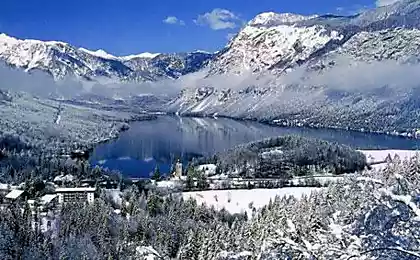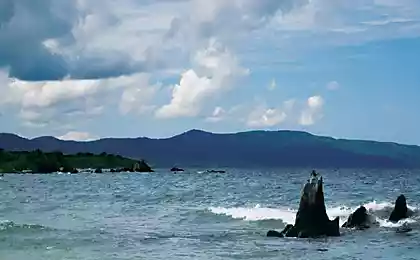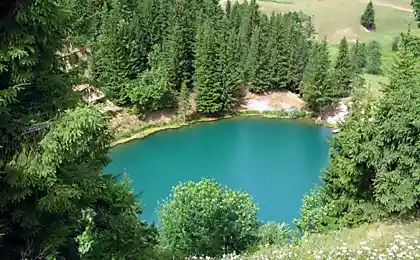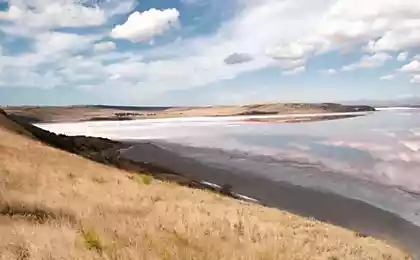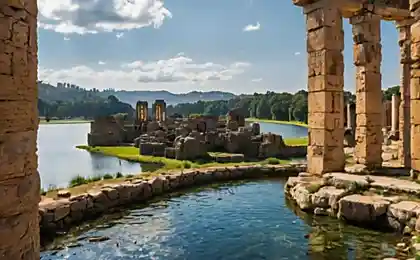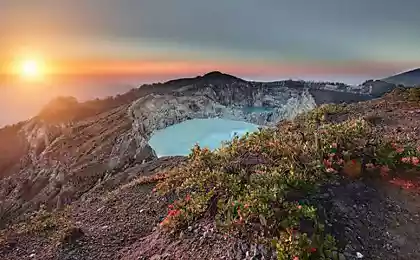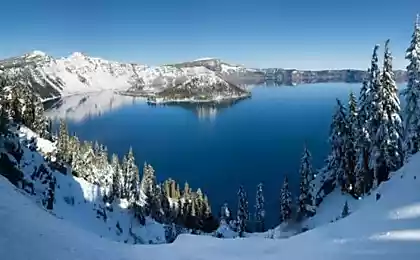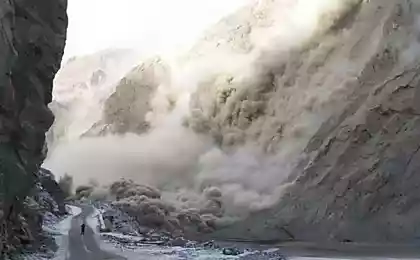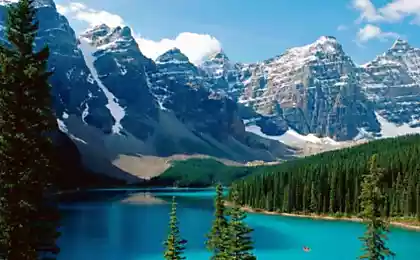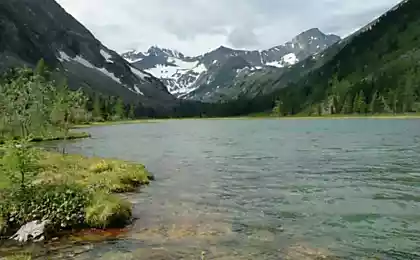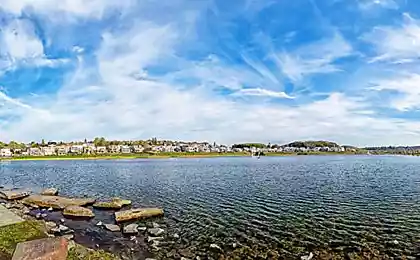1324
Lakes of the World
Most large and not very Lakes - is not only a source of drinking water, but also significant tourist sites. Before you eight amazing lakes in the world, we'll show you exactly what they are and why they are noteworthy worth seeing.
Titicaca: the largest reserves of fresh water mountain lake
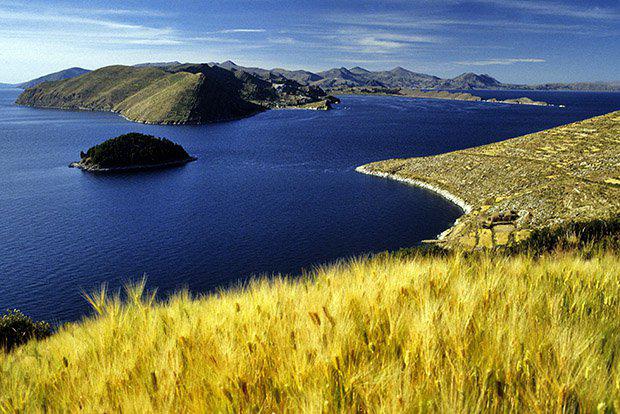
Where there are: South America; Peru and Bolivia
Its area is comparable to the area of the island of Crete - about 8300 square meters. km. On the plane, it looks like the sea, but when viewed from the shore in places like swamp overgrown with reeds. People are moving cautiously, looking at the ground, as they walk through the mud furnace. Reed everywhere, and it is made all - clothing, hats, bags, home and the island on which they live. Legend has it that once upon a time the Aymara Indians, swimming across the lake in their canoes, were in the territory of the Incas. Get on the two peoples could not but return back home proud Aymara did not - decide that and will float on the lake. Since they live on reed islands, rafts, decoration resembling ancient Egyptian court.
Cheongju most high crater lake

Where there are: Asia; on the border between China and North Korea.
The shoreline of this lake is situated at an altitude of 2189 m above sea level, so Cheongju called "Heavenly Lake". It is surrounded by winding mountain trails on which you can ride on horseback. With Cheongju linked several North Korean legends. According to legend, to the shores of a mountain lake from the sky came down Hwanung, whose son founded the Korean state Gojoseon. The second in the ranking of popular myth - about Kim Jong Il: Locals claim seriously tourists, son of the founder of the DPRK, Kim Il Sung was born here, on the shores of the lake.
Crater, one of the cleanest lakes
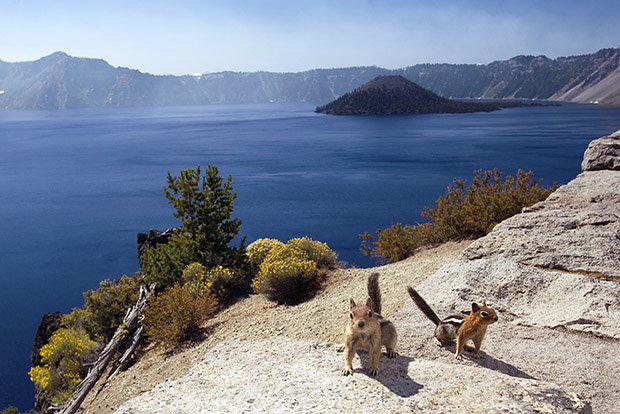
Where located: North America; US
You can reach it by car or tour bus, which departs from the city of Ashland. 53-kilometer road encircling the lake opens in late spring and closes for the winter in October, but in the summer months traveling in her amazing views. Indians Klamath Lake is considered sacred, they kept the location secret until the middle of the XIX century, not allowing it to white explorers. The first white man who saw the lake in 1853, was John Wesley Hillman. He called it a "deep blue lake", and in 1902, Theodore Roosevelt declared the area a national park lake. Its main attractions - a small volcanic island, called "Witching" and "Lake the old man" - the nine-beam vertically floating in the water for more than a century.
Nakuru: populated flamingo lake
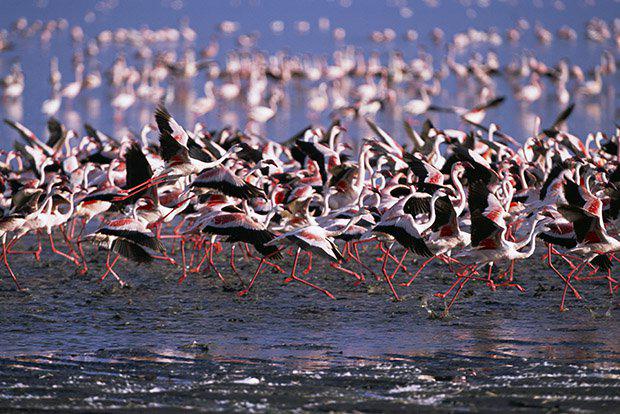
Where there are: Africa; Kenya
140 km from the Kenyan capital Nairobi is Lake Nakuru - a haven of small flamingos. Tens of thousands of birds, sitting down and taking off the canvas to form various shades of pink. Flamingos are not the only inhabitants of the lake: in addition they are feeding pelicans, cormorants and many species of ducks, herons, black terns - a total of about 400 species of birds. The lake is part of the national park of the same name, so tourists who went to its shores, along the way can see zebras, hippos, giraffes, antelopes, lions, cheetahs and leopards.
Spotted Lake: consisting of a very large number of small lakes
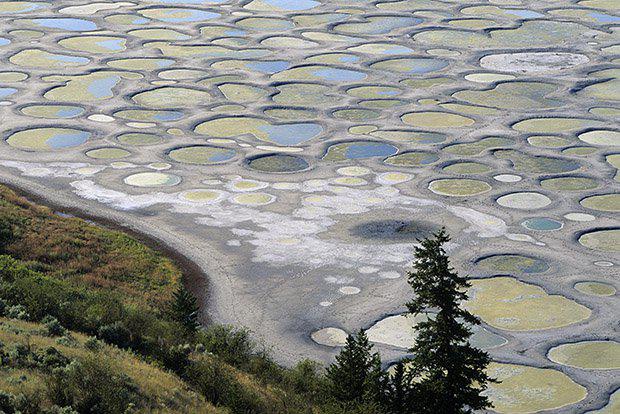
Where located: North America; Canada
In the summer most of the water in Lake Spotted Lake evaporates, and the remaining minerals harden and form a "path" between 365 small lakes, due to which he was called "Spotted Lake." Remarkably, there is no nearby hotel or a souvenir shop. In 1979, businessman Ernest Slim attempted to arrange a resort here, but the initiative immediately stopped the Indians. Twenty years indigenous people have fought for the preservation of the lake and its surroundings in its original form, and in 2001 succeeded! They bought territory completely and made lake Spotted Lake Reserve.
Jiuzhaigou: frost lake without a thermal source
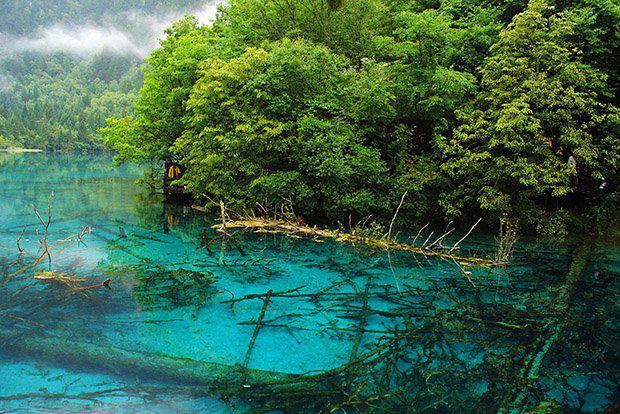
Where there are: Asia; China
Each day, hundreds of tourist buses carry tourists to the scenic route along the curved lakes and rapid waterfalls surrounded by bamboo thickets. The trip takes an hour, but if there is no cloud cover, then Jiuzhaigou Nature Reserve in Chengdu City can be reached in 40 minutes. The main attraction of the reserve - Lake five colors, which does not freeze in winter. Initially, scientists believed this occurs due to the bottom of hot springs, but detect any hitherto failed. The lake bottom is covered with tree trunks, and in theory, the water in it to be muddy, but for some inexplicable reason, yet it still remains clear and clean.
Pitch Lake: Lake asphalt

Where there are: the Caribbean; Trinidad and Tobago
The lake consists of a liquid natural asphalt, which is about 6 million tons: Scientists estimate that it will last for another 400 years. However, its smooth surface is not only thick steaming asphalt - in the area there are many places where it is possible to swim, so the Pitch Lake annually attracts about 20,000 people. On the lake there is a tourist center and museum where artifacts at different times extracted from the water - for example, Native American pottery and bones of a giant sloth.
Hiller: the world's only pink lake

Where there are: Australia; Recherche Archipelago
Hiller lake famous for the fact that its waters are colored in pink. Scientists are still struggling with the mystery, which gives it a unique character. It has been speculated that the reason the algae, but studies of water samples showed that it is not so: no audio algae, contributing to pink. The lake is surrounded by a belt of white salt and eucalyptus evergreen forest. And there is another unique feature of this reservoir: all known for his photographs are taken with a bird's eye because of Middle West Australian island, which is a lake closed to tourists.
Titicaca: the largest reserves of fresh water mountain lake

Where there are: South America; Peru and Bolivia
Its area is comparable to the area of the island of Crete - about 8300 square meters. km. On the plane, it looks like the sea, but when viewed from the shore in places like swamp overgrown with reeds. People are moving cautiously, looking at the ground, as they walk through the mud furnace. Reed everywhere, and it is made all - clothing, hats, bags, home and the island on which they live. Legend has it that once upon a time the Aymara Indians, swimming across the lake in their canoes, were in the territory of the Incas. Get on the two peoples could not but return back home proud Aymara did not - decide that and will float on the lake. Since they live on reed islands, rafts, decoration resembling ancient Egyptian court.
Cheongju most high crater lake

Where there are: Asia; on the border between China and North Korea.
The shoreline of this lake is situated at an altitude of 2189 m above sea level, so Cheongju called "Heavenly Lake". It is surrounded by winding mountain trails on which you can ride on horseback. With Cheongju linked several North Korean legends. According to legend, to the shores of a mountain lake from the sky came down Hwanung, whose son founded the Korean state Gojoseon. The second in the ranking of popular myth - about Kim Jong Il: Locals claim seriously tourists, son of the founder of the DPRK, Kim Il Sung was born here, on the shores of the lake.
Crater, one of the cleanest lakes

Where located: North America; US
You can reach it by car or tour bus, which departs from the city of Ashland. 53-kilometer road encircling the lake opens in late spring and closes for the winter in October, but in the summer months traveling in her amazing views. Indians Klamath Lake is considered sacred, they kept the location secret until the middle of the XIX century, not allowing it to white explorers. The first white man who saw the lake in 1853, was John Wesley Hillman. He called it a "deep blue lake", and in 1902, Theodore Roosevelt declared the area a national park lake. Its main attractions - a small volcanic island, called "Witching" and "Lake the old man" - the nine-beam vertically floating in the water for more than a century.
Nakuru: populated flamingo lake

Where there are: Africa; Kenya
140 km from the Kenyan capital Nairobi is Lake Nakuru - a haven of small flamingos. Tens of thousands of birds, sitting down and taking off the canvas to form various shades of pink. Flamingos are not the only inhabitants of the lake: in addition they are feeding pelicans, cormorants and many species of ducks, herons, black terns - a total of about 400 species of birds. The lake is part of the national park of the same name, so tourists who went to its shores, along the way can see zebras, hippos, giraffes, antelopes, lions, cheetahs and leopards.
Spotted Lake: consisting of a very large number of small lakes

Where located: North America; Canada
In the summer most of the water in Lake Spotted Lake evaporates, and the remaining minerals harden and form a "path" between 365 small lakes, due to which he was called "Spotted Lake." Remarkably, there is no nearby hotel or a souvenir shop. In 1979, businessman Ernest Slim attempted to arrange a resort here, but the initiative immediately stopped the Indians. Twenty years indigenous people have fought for the preservation of the lake and its surroundings in its original form, and in 2001 succeeded! They bought territory completely and made lake Spotted Lake Reserve.
Jiuzhaigou: frost lake without a thermal source

Where there are: Asia; China
Each day, hundreds of tourist buses carry tourists to the scenic route along the curved lakes and rapid waterfalls surrounded by bamboo thickets. The trip takes an hour, but if there is no cloud cover, then Jiuzhaigou Nature Reserve in Chengdu City can be reached in 40 minutes. The main attraction of the reserve - Lake five colors, which does not freeze in winter. Initially, scientists believed this occurs due to the bottom of hot springs, but detect any hitherto failed. The lake bottom is covered with tree trunks, and in theory, the water in it to be muddy, but for some inexplicable reason, yet it still remains clear and clean.
Pitch Lake: Lake asphalt

Where there are: the Caribbean; Trinidad and Tobago
The lake consists of a liquid natural asphalt, which is about 6 million tons: Scientists estimate that it will last for another 400 years. However, its smooth surface is not only thick steaming asphalt - in the area there are many places where it is possible to swim, so the Pitch Lake annually attracts about 20,000 people. On the lake there is a tourist center and museum where artifacts at different times extracted from the water - for example, Native American pottery and bones of a giant sloth.
Hiller: the world's only pink lake

Where there are: Australia; Recherche Archipelago
Hiller lake famous for the fact that its waters are colored in pink. Scientists are still struggling with the mystery, which gives it a unique character. It has been speculated that the reason the algae, but studies of water samples showed that it is not so: no audio algae, contributing to pink. The lake is surrounded by a belt of white salt and eucalyptus evergreen forest. And there is another unique feature of this reservoir: all known for his photographs are taken with a bird's eye because of Middle West Australian island, which is a lake closed to tourists.

